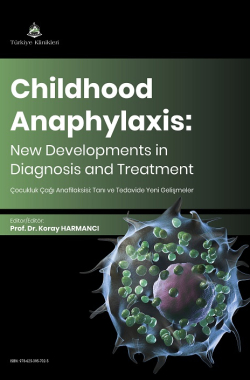OBSERVATION AND DISCHARGE IN ANAPHYLAXIS
Hande Üçler Çınar1 Murat Cansever2
1Kayseri City Training and Research Hospital, Department of Pediatric Immunology and Allergic Diseases, Kayseri, Türkiye
2Kayseri City Training and Research Hospital, Department of Pediatric Immunology and Allergic Diseases, Kayseri, Türkiye
Üçler Çınar H, Cansever M. Observation and Discharge in Anaphylaxis. In: Harmancı K, editor. Childhood Anaphylaxis: New Developments in Diagnosis and Treatment. 1st ed. Ankara: Türkiye Klinikleri; 2025. p.267-272.
ABSTRACT
Post-anaphylaxis observation is essential for patient safety. Healthcare providers should be aware of the risk of biphasic reactions and tailor the duration and setting of monitoring based on individual patient factors. Following symptom resolution, observe patients with moderate to severe anaphylaxis for at least 4 hours following adrenaline administration; this observation period may be extended to 8-10 hours if clinically indicated. Cases with refractory or protracted anaphylaxis may require observation for several days. During the observation period, the patient’s respiratory/cardiac status should be monitored regularly. Discharge planning must include providing the patient an anaphylaxis action plan, prescribing an adrenaline autoinjector for use when necessary, explaining how to use it and storage conditions, and referring the patient to an allergy specialist for long-term follow-up.
Keywords: Anaphylaxis; Adrenaline; Emergency treatment; Observation; Discharge
Kaynak Göster
Referanslar
- Tanverdi MS, Wiersma A, Kim KM, Hicks AG, Mistry RD. Anaphylaxis in Children. Pediatr Emerg Care. 2022;38(9):456-461. (In eng). [Crossref] [PubMed]
- Golden DBK, Wang J, Waserman S, Akin C, Campbell RL, Ellis AK, et al. Anaphylaxis: A 2023 practice parameter update. Annals of Allergy, Asthma & Immunology. 2024;132(2):124-176. [Crossref] [PubMed]
- Short HB, Walters B, Fabi M, Ravida N, Boehmer S, Reyes L. Evaluating Practice Patterns of Observation Periods Following Epinephrine Administration for Anaphylaxis Among Pediatric Patients. Cureus. 2024;16(9):e69419. (In eng). [Crossref]
- Muraro A, Worm M, Alviani C, Cardona V, DunnGalvin A, Garvey LH, et al. EAACI guidelines: Anaphylaxis (2021 update). Allergy. 2022;77(2):357-377. [Crossref] [PubMed]
- Miller JM, Forbes-Satter L. Risk Factors for Severe Anaphylaxis in Children. Pediatrics. 2021;148(Supplement 3):S9S9. [Crossref]
- Lee J, Rodio B, Lavelle J, Lewis MO, English R, Hadley S, et al. Improving Anaphylaxis Care: The Impact of a Clinical Pathway. Pediatrics. 2018;141(5) (In eng). [Crossref] [PubMed]
- National Institute for Health and Care Excellence: Guidelines. Anaphylaxis: assessment and referral after emergency treatment. London: National Institute for Health and Care Excellence (NICE) Copyright © NICE. 2020;2020.
- Ruhsatlı Beşeri Tıbbi Ürünler Listesi. Türkiye İlaç ve Tıbbi Cihaz Kurumu. [Access date: 01.05.2025].
- Adrenaline auto-injectors (AAIs). European Medicines Agency. [Access date: 15.04.2025].
- Navalpakam A, Thanaputkaiporn N, Poowuttikul P. Anaphylaxis: Long-term management and resources. Allergy Asthma Proc. 2023;44(1):35-44. (In eng). [Crossref] [PubMed]
- Anaphylaxis: assessment and referral after emergency treatment. London: National Institute for Health and Care Excellence (NICE). [Access date: 13.5.2025].
- DuToit G, Smith P, Muraro A, Fox AT, Roberts G, Ring J, et al. Identifying patients at risk of anaphylaxis. World Allergy Organ J. 2024;17(6):100904. (In eng). [Crossref] [PubMed] [PMC]
- Cernadas J, Vasconcelos MJ, Carneiro-Leão L. Desensitization in children allergic to drugs: Indications, protocols, and limits. Pediatr Allergy Immunol. 2023;34(6):e13965. (In eng). [Crossref] [PubMed]

